Asthma Patient: Symptoms, Triggers, Pathogenesis, Diagnosis, and Nursing Strategies
VerifiedAdded on 2023/06/03
|14
|2832
|60
AI Summary
This article discusses acute severe asthma, its symptoms, trigger factors, pathogenesis, diagnosis, and nursing strategies. It also covers the use of drugs like Salbutamol, Nebulised Ipratropium bromide, and IV Hydrocortisone 100mg in treating asthma patients.
Contribute Materials
Your contribution can guide someone’s learning journey. Share your
documents today.

Running Head: ASTHMA PATIENT
0
Asthma Patient
2018
0
Asthma Patient
2018
Secure Best Marks with AI Grader
Need help grading? Try our AI Grader for instant feedback on your assignments.

ASTHMA PATIENT
1
Contents
Part one.................................................................................................................................................2
Part two.................................................................................................................................................5
Part three..............................................................................................................................................6
References.............................................................................................................................................9
1
Contents
Part one.................................................................................................................................................2
Part two.................................................................................................................................................5
Part three..............................................................................................................................................6
References.............................................................................................................................................9
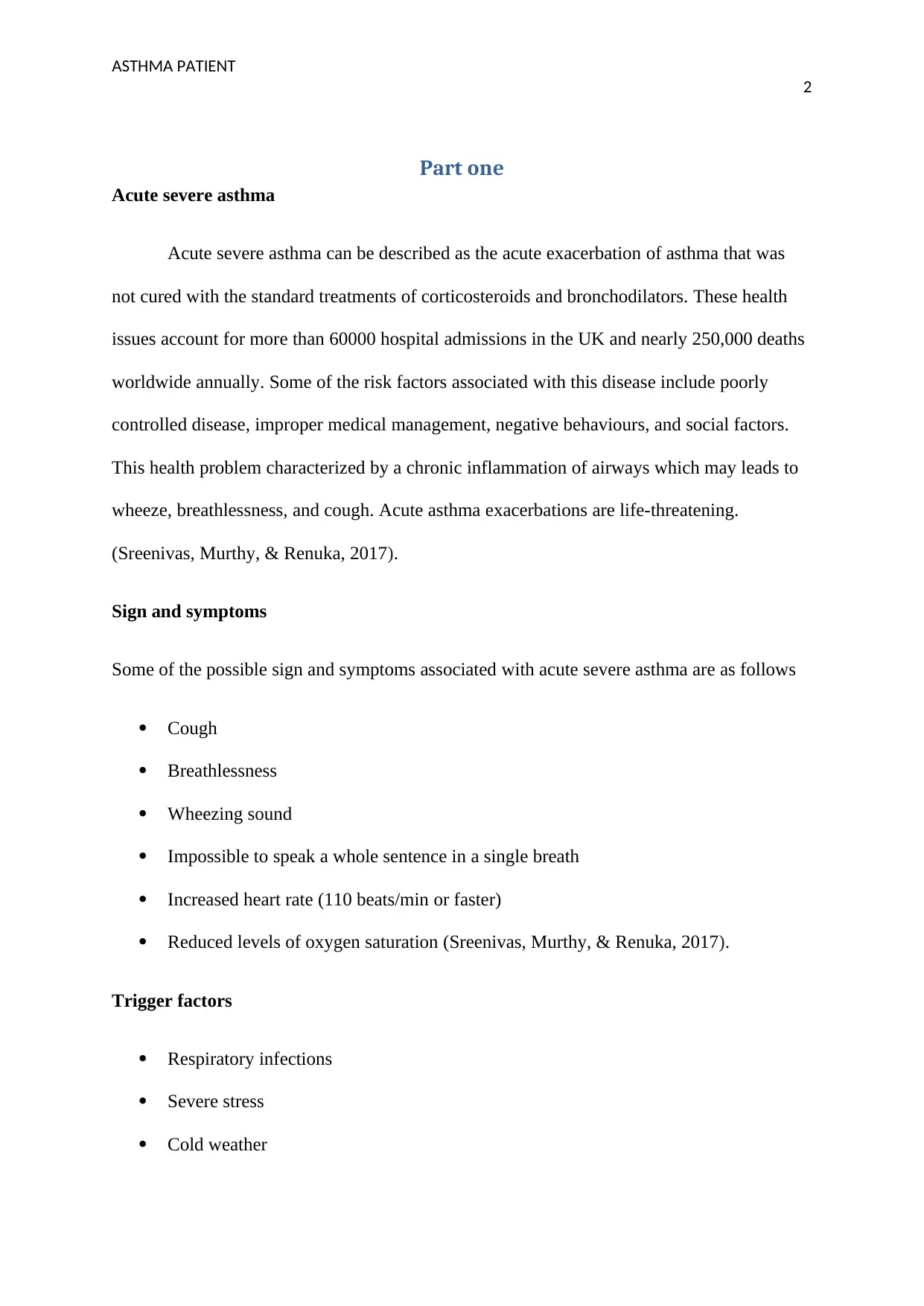
ASTHMA PATIENT
2
Part one
Acute severe asthma
Acute severe asthma can be described as the acute exacerbation of asthma that was
not cured with the standard treatments of corticosteroids and bronchodilators. These health
issues account for more than 60000 hospital admissions in the UK and nearly 250,000 deaths
worldwide annually. Some of the risk factors associated with this disease include poorly
controlled disease, improper medical management, negative behaviours, and social factors.
This health problem characterized by a chronic inflammation of airways which may leads to
wheeze, breathlessness, and cough. Acute asthma exacerbations are life-threatening.
(Sreenivas, Murthy, & Renuka, 2017).
Sign and symptoms
Some of the possible sign and symptoms associated with acute severe asthma are as follows
Cough
Breathlessness
Wheezing sound
Impossible to speak a whole sentence in a single breath
Increased heart rate (110 beats/min or faster)
Reduced levels of oxygen saturation (Sreenivas, Murthy, & Renuka, 2017).
Trigger factors
Respiratory infections
Severe stress
Cold weather
2
Part one
Acute severe asthma
Acute severe asthma can be described as the acute exacerbation of asthma that was
not cured with the standard treatments of corticosteroids and bronchodilators. These health
issues account for more than 60000 hospital admissions in the UK and nearly 250,000 deaths
worldwide annually. Some of the risk factors associated with this disease include poorly
controlled disease, improper medical management, negative behaviours, and social factors.
This health problem characterized by a chronic inflammation of airways which may leads to
wheeze, breathlessness, and cough. Acute asthma exacerbations are life-threatening.
(Sreenivas, Murthy, & Renuka, 2017).
Sign and symptoms
Some of the possible sign and symptoms associated with acute severe asthma are as follows
Cough
Breathlessness
Wheezing sound
Impossible to speak a whole sentence in a single breath
Increased heart rate (110 beats/min or faster)
Reduced levels of oxygen saturation (Sreenivas, Murthy, & Renuka, 2017).
Trigger factors
Respiratory infections
Severe stress
Cold weather
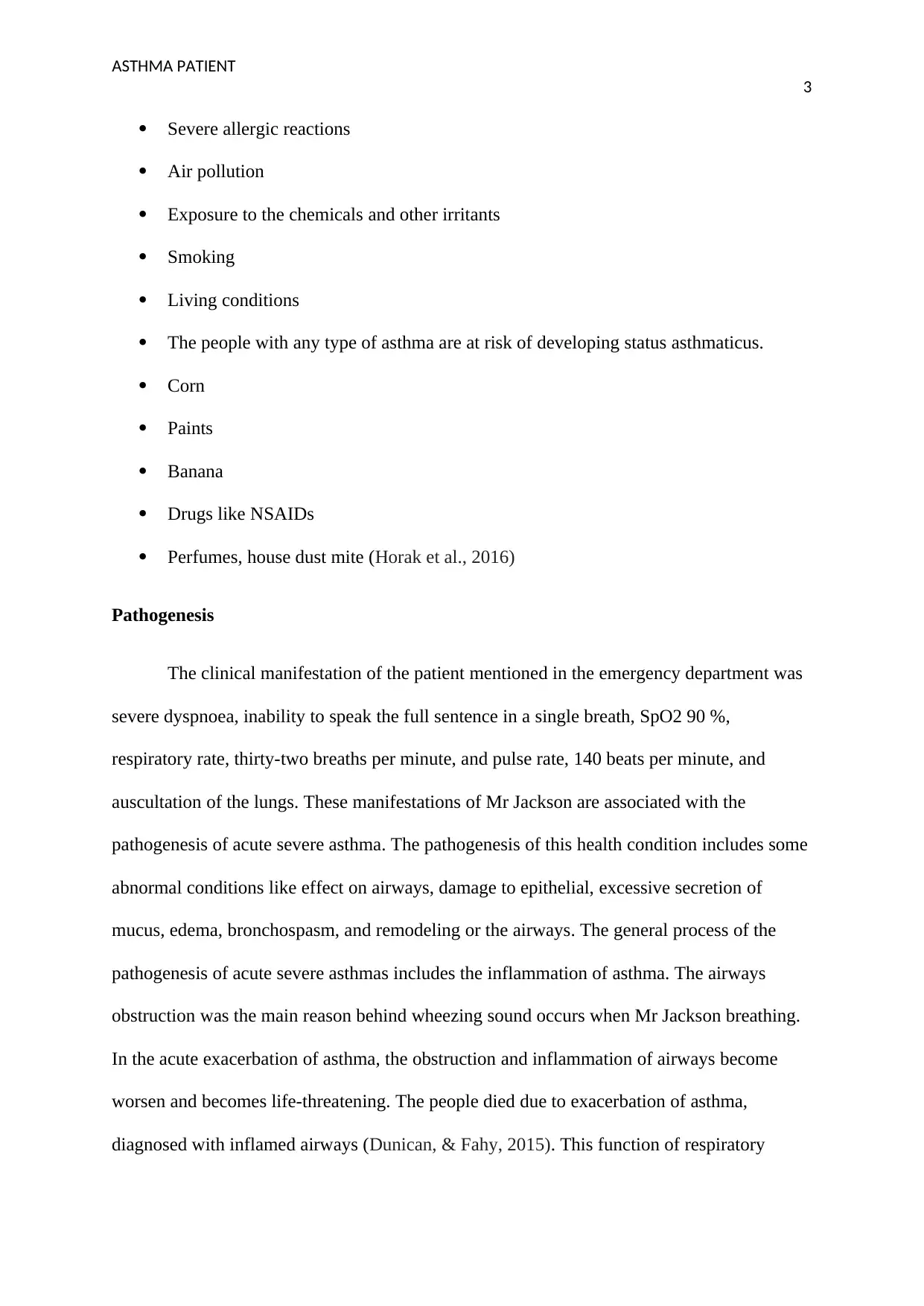
ASTHMA PATIENT
3
Severe allergic reactions
Air pollution
Exposure to the chemicals and other irritants
Smoking
Living conditions
The people with any type of asthma are at risk of developing status asthmaticus.
Corn
Paints
Banana
Drugs like NSAIDs
Perfumes, house dust mite (Horak et al., 2016)
Pathogenesis
The clinical manifestation of the patient mentioned in the emergency department was
severe dyspnoea, inability to speak the full sentence in a single breath, SpO2 90 %,
respiratory rate, thirty-two breaths per minute, and pulse rate, 140 beats per minute, and
auscultation of the lungs. These manifestations of Mr Jackson are associated with the
pathogenesis of acute severe asthma. The pathogenesis of this health condition includes some
abnormal conditions like effect on airways, damage to epithelial, excessive secretion of
mucus, edema, bronchospasm, and remodeling or the airways. The general process of the
pathogenesis of acute severe asthmas includes the inflammation of asthma. The airways
obstruction was the main reason behind wheezing sound occurs when Mr Jackson breathing.
In the acute exacerbation of asthma, the obstruction and inflammation of airways become
worsen and becomes life-threatening. The people died due to exacerbation of asthma,
diagnosed with inflamed airways (Dunican, & Fahy, 2015). This function of respiratory
3
Severe allergic reactions
Air pollution
Exposure to the chemicals and other irritants
Smoking
Living conditions
The people with any type of asthma are at risk of developing status asthmaticus.
Corn
Paints
Banana
Drugs like NSAIDs
Perfumes, house dust mite (Horak et al., 2016)
Pathogenesis
The clinical manifestation of the patient mentioned in the emergency department was
severe dyspnoea, inability to speak the full sentence in a single breath, SpO2 90 %,
respiratory rate, thirty-two breaths per minute, and pulse rate, 140 beats per minute, and
auscultation of the lungs. These manifestations of Mr Jackson are associated with the
pathogenesis of acute severe asthma. The pathogenesis of this health condition includes some
abnormal conditions like effect on airways, damage to epithelial, excessive secretion of
mucus, edema, bronchospasm, and remodeling or the airways. The general process of the
pathogenesis of acute severe asthmas includes the inflammation of asthma. The airways
obstruction was the main reason behind wheezing sound occurs when Mr Jackson breathing.
In the acute exacerbation of asthma, the obstruction and inflammation of airways become
worsen and becomes life-threatening. The people died due to exacerbation of asthma,
diagnosed with inflamed airways (Dunican, & Fahy, 2015). This function of respiratory
Secure Best Marks with AI Grader
Need help grading? Try our AI Grader for instant feedback on your assignments.
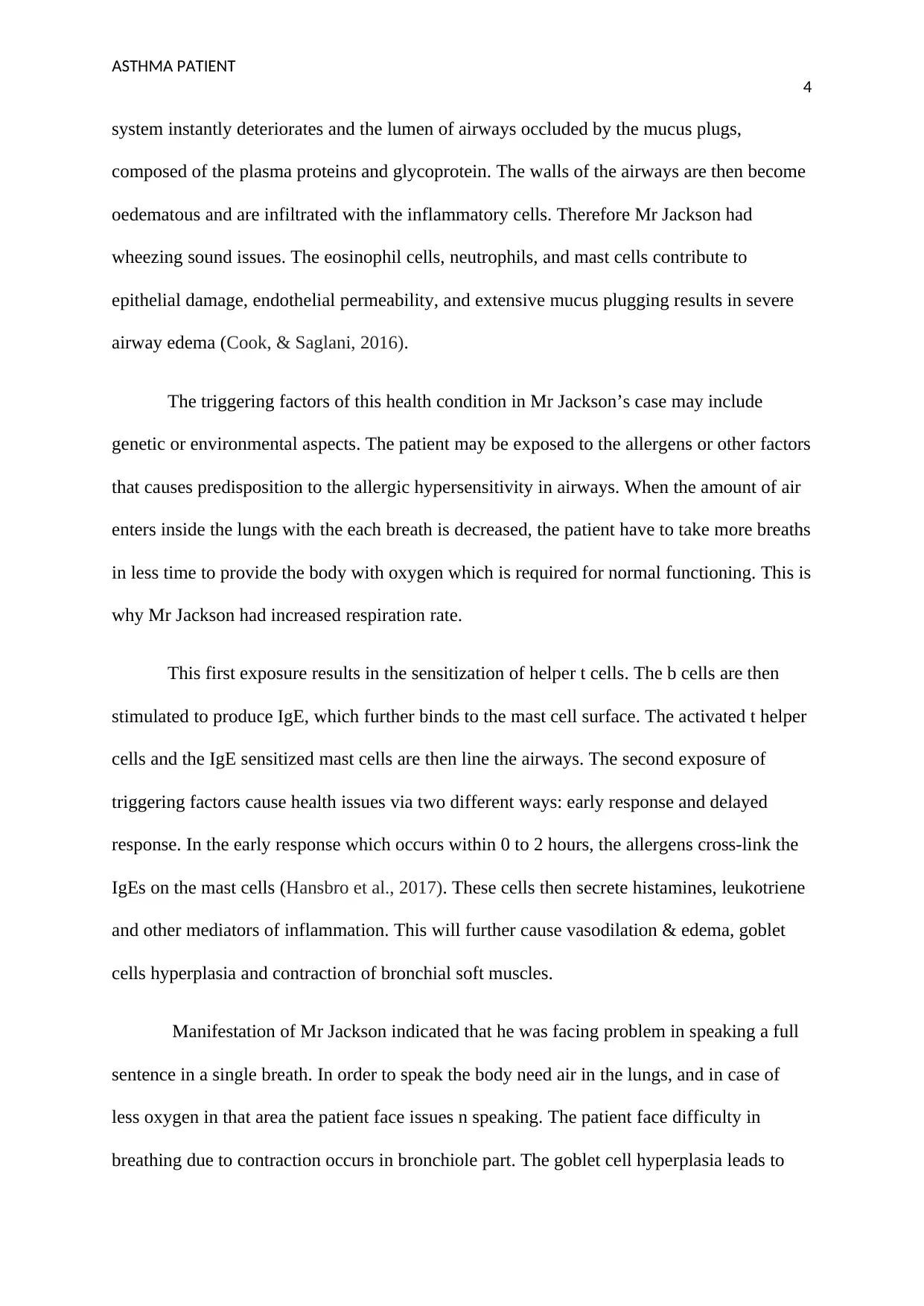
ASTHMA PATIENT
4
system instantly deteriorates and the lumen of airways occluded by the mucus plugs,
composed of the plasma proteins and glycoprotein. The walls of the airways are then become
oedematous and are infiltrated with the inflammatory cells. Therefore Mr Jackson had
wheezing sound issues. The eosinophil cells, neutrophils, and mast cells contribute to
epithelial damage, endothelial permeability, and extensive mucus plugging results in severe
airway edema (Cook, & Saglani, 2016).
The triggering factors of this health condition in Mr Jackson’s case may include
genetic or environmental aspects. The patient may be exposed to the allergens or other factors
that causes predisposition to the allergic hypersensitivity in airways. When the amount of air
enters inside the lungs with the each breath is decreased, the patient have to take more breaths
in less time to provide the body with oxygen which is required for normal functioning. This is
why Mr Jackson had increased respiration rate.
This first exposure results in the sensitization of helper t cells. The b cells are then
stimulated to produce IgE, which further binds to the mast cell surface. The activated t helper
cells and the IgE sensitized mast cells are then line the airways. The second exposure of
triggering factors cause health issues via two different ways: early response and delayed
response. In the early response which occurs within 0 to 2 hours, the allergens cross-link the
IgEs on the mast cells (Hansbro et al., 2017). These cells then secrete histamines, leukotriene
and other mediators of inflammation. This will further cause vasodilation & edema, goblet
cells hyperplasia and contraction of bronchial soft muscles.
Manifestation of Mr Jackson indicated that he was facing problem in speaking a full
sentence in a single breath. In order to speak the body need air in the lungs, and in case of
less oxygen in that area the patient face issues n speaking. The patient face difficulty in
breathing due to contraction occurs in bronchiole part. The goblet cell hyperplasia leads to
4
system instantly deteriorates and the lumen of airways occluded by the mucus plugs,
composed of the plasma proteins and glycoprotein. The walls of the airways are then become
oedematous and are infiltrated with the inflammatory cells. Therefore Mr Jackson had
wheezing sound issues. The eosinophil cells, neutrophils, and mast cells contribute to
epithelial damage, endothelial permeability, and extensive mucus plugging results in severe
airway edema (Cook, & Saglani, 2016).
The triggering factors of this health condition in Mr Jackson’s case may include
genetic or environmental aspects. The patient may be exposed to the allergens or other factors
that causes predisposition to the allergic hypersensitivity in airways. When the amount of air
enters inside the lungs with the each breath is decreased, the patient have to take more breaths
in less time to provide the body with oxygen which is required for normal functioning. This is
why Mr Jackson had increased respiration rate.
This first exposure results in the sensitization of helper t cells. The b cells are then
stimulated to produce IgE, which further binds to the mast cell surface. The activated t helper
cells and the IgE sensitized mast cells are then line the airways. The second exposure of
triggering factors cause health issues via two different ways: early response and delayed
response. In the early response which occurs within 0 to 2 hours, the allergens cross-link the
IgEs on the mast cells (Hansbro et al., 2017). These cells then secrete histamines, leukotriene
and other mediators of inflammation. This will further cause vasodilation & edema, goblet
cells hyperplasia and contraction of bronchial soft muscles.
Manifestation of Mr Jackson indicated that he was facing problem in speaking a full
sentence in a single breath. In order to speak the body need air in the lungs, and in case of
less oxygen in that area the patient face issues n speaking. The patient face difficulty in
breathing due to contraction occurs in bronchiole part. The goblet cell hyperplasia leads to
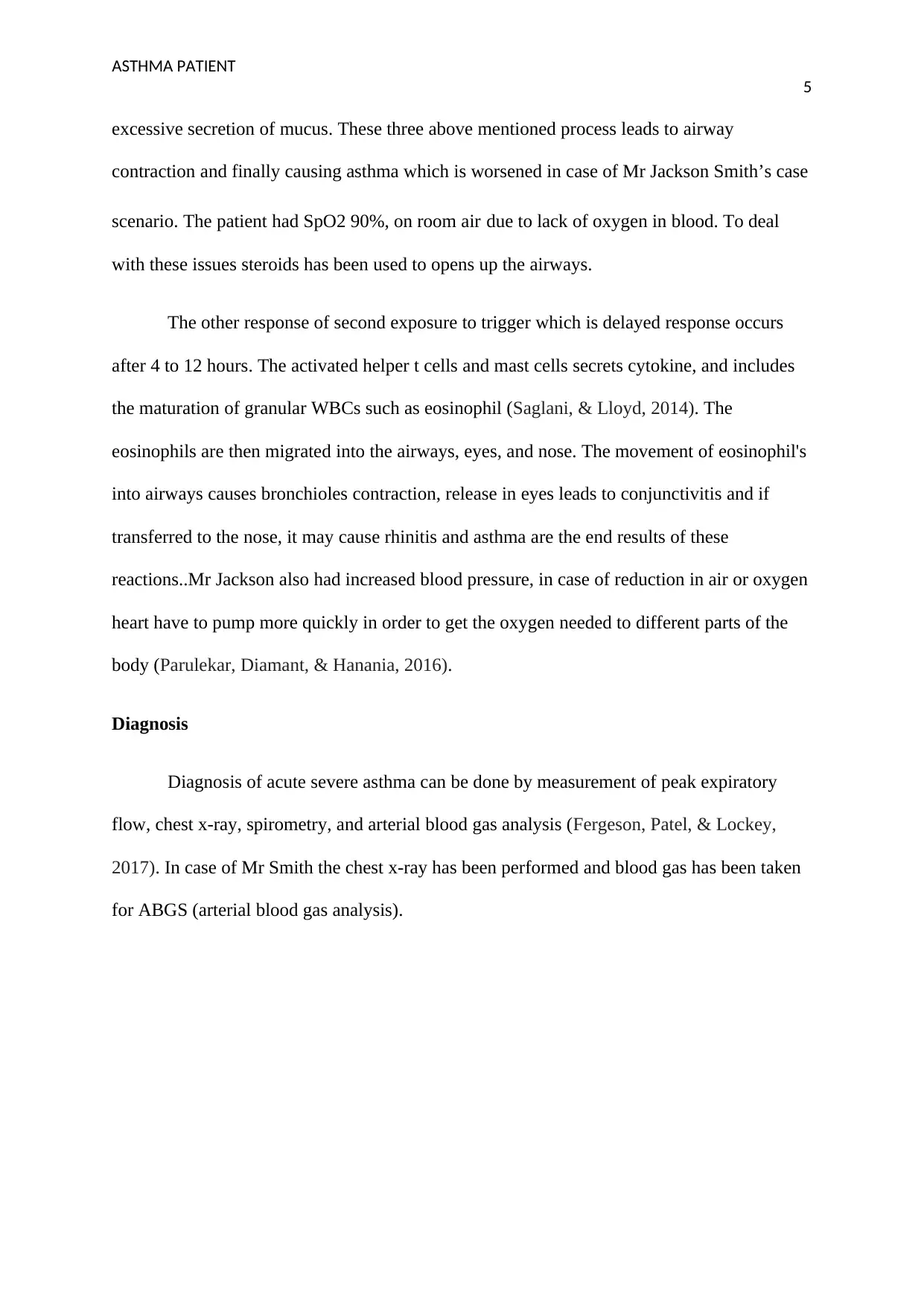
ASTHMA PATIENT
5
excessive secretion of mucus. These three above mentioned process leads to airway
contraction and finally causing asthma which is worsened in case of Mr Jackson Smith’s case
scenario. The patient had SpO2 90%, on room air due to lack of oxygen in blood. To deal
with these issues steroids has been used to opens up the airways.
The other response of second exposure to trigger which is delayed response occurs
after 4 to 12 hours. The activated helper t cells and mast cells secrets cytokine, and includes
the maturation of granular WBCs such as eosinophil (Saglani, & Lloyd, 2014). The
eosinophils are then migrated into the airways, eyes, and nose. The movement of eosinophil's
into airways causes bronchioles contraction, release in eyes leads to conjunctivitis and if
transferred to the nose, it may cause rhinitis and asthma are the end results of these
reactions..Mr Jackson also had increased blood pressure, in case of reduction in air or oxygen
heart have to pump more quickly in order to get the oxygen needed to different parts of the
body (Parulekar, Diamant, & Hanania, 2016).
Diagnosis
Diagnosis of acute severe asthma can be done by measurement of peak expiratory
flow, chest x-ray, spirometry, and arterial blood gas analysis (Fergeson, Patel, & Lockey,
2017). In case of Mr Smith the chest x-ray has been performed and blood gas has been taken
for ABGS (arterial blood gas analysis).
5
excessive secretion of mucus. These three above mentioned process leads to airway
contraction and finally causing asthma which is worsened in case of Mr Jackson Smith’s case
scenario. The patient had SpO2 90%, on room air due to lack of oxygen in blood. To deal
with these issues steroids has been used to opens up the airways.
The other response of second exposure to trigger which is delayed response occurs
after 4 to 12 hours. The activated helper t cells and mast cells secrets cytokine, and includes
the maturation of granular WBCs such as eosinophil (Saglani, & Lloyd, 2014). The
eosinophils are then migrated into the airways, eyes, and nose. The movement of eosinophil's
into airways causes bronchioles contraction, release in eyes leads to conjunctivitis and if
transferred to the nose, it may cause rhinitis and asthma are the end results of these
reactions..Mr Jackson also had increased blood pressure, in case of reduction in air or oxygen
heart have to pump more quickly in order to get the oxygen needed to different parts of the
body (Parulekar, Diamant, & Hanania, 2016).
Diagnosis
Diagnosis of acute severe asthma can be done by measurement of peak expiratory
flow, chest x-ray, spirometry, and arterial blood gas analysis (Fergeson, Patel, & Lockey,
2017). In case of Mr Smith the chest x-ray has been performed and blood gas has been taken
for ABGS (arterial blood gas analysis).

ASTHMA PATIENT
6
Part two
Nursing strategies
Assessment
Acute severe asthma is the life threating disorder which needs to be diagnosed and
treated earlier as possible. The severity of the disease (moderate, severe or life threatening)
should be assessed on the basis of clinical observations and measurement of pulse oximetry.
Before applying oxygen therapy assessment of alteration in rate (tachycardia, bradycardia and
apnea), depth of respiration, changes in colour, and irritability should be done.
As mentioned in the case study, Mr Jackson has acute severe asthma which is the life
threatening disorder. Therefore nurses should observe the vital signs of the patient. Regular
assessment and observation of the asthma patient are necessary to notice any life-threatening
symptoms that can occur during the hospital stay. As discuses in the case study the patient
has manifestations like severe dyspnoea, abnormal respiration rate, and pulse rate, increased
blood pressure, and auscultation of the lungs, therefore patient assessment is important. The
disease person should be provided with supplemented oxygen to maintain the arterial oxygen
saturation higher than 90 per cent. The patient should be assessed for A nurse should observe
the vital sign such as oxygen exchange, respiratory rate, BP, pulse rate, temperature and the
patient's position on the bed (FitzGerald et al., 2016).
Oxygen therapy
Mr Jackson has been admitted to the ICU department for severe breathing issue,
increased BP which recorded 150/85 mmHg, and PR (pulse rate) of 130 beats/ minute.
Whispering Wheezing was also observed when Mr Smith admitted to the ICU department.
Therefore to maintain the oxygen availability oxygen therapy is the most important nursing
6
Part two
Nursing strategies
Assessment
Acute severe asthma is the life threating disorder which needs to be diagnosed and
treated earlier as possible. The severity of the disease (moderate, severe or life threatening)
should be assessed on the basis of clinical observations and measurement of pulse oximetry.
Before applying oxygen therapy assessment of alteration in rate (tachycardia, bradycardia and
apnea), depth of respiration, changes in colour, and irritability should be done.
As mentioned in the case study, Mr Jackson has acute severe asthma which is the life
threatening disorder. Therefore nurses should observe the vital signs of the patient. Regular
assessment and observation of the asthma patient are necessary to notice any life-threatening
symptoms that can occur during the hospital stay. As discuses in the case study the patient
has manifestations like severe dyspnoea, abnormal respiration rate, and pulse rate, increased
blood pressure, and auscultation of the lungs, therefore patient assessment is important. The
disease person should be provided with supplemented oxygen to maintain the arterial oxygen
saturation higher than 90 per cent. The patient should be assessed for A nurse should observe
the vital sign such as oxygen exchange, respiratory rate, BP, pulse rate, temperature and the
patient's position on the bed (FitzGerald et al., 2016).
Oxygen therapy
Mr Jackson has been admitted to the ICU department for severe breathing issue,
increased BP which recorded 150/85 mmHg, and PR (pulse rate) of 130 beats/ minute.
Whispering Wheezing was also observed when Mr Smith admitted to the ICU department.
Therefore to maintain the oxygen availability oxygen therapy is the most important nursing
Paraphrase This Document
Need a fresh take? Get an instant paraphrase of this document with our AI Paraphraser
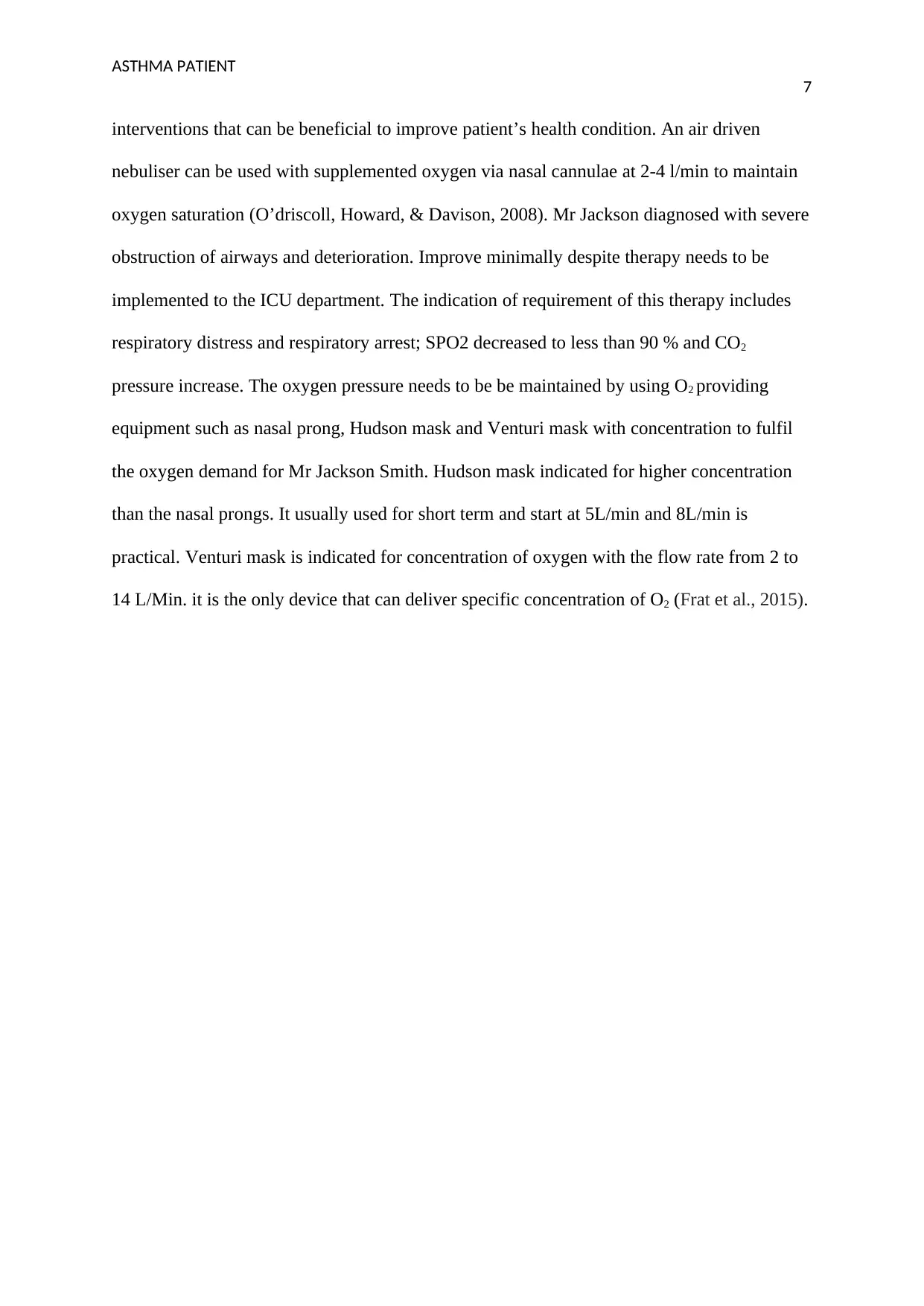
ASTHMA PATIENT
7
interventions that can be beneficial to improve patient’s health condition. An air driven
nebuliser can be used with supplemented oxygen via nasal cannulae at 2-4 l/min to maintain
oxygen saturation (O’driscoll, Howard, & Davison, 2008). Mr Jackson diagnosed with severe
obstruction of airways and deterioration. Improve minimally despite therapy needs to be
implemented to the ICU department. The indication of requirement of this therapy includes
respiratory distress and respiratory arrest; SPO2 decreased to less than 90 % and CO2
pressure increase. The oxygen pressure needs to be be maintained by using O2 providing
equipment such as nasal prong, Hudson mask and Venturi mask with concentration to fulfil
the oxygen demand for Mr Jackson Smith. Hudson mask indicated for higher concentration
than the nasal prongs. It usually used for short term and start at 5L/min and 8L/min is
practical. Venturi mask is indicated for concentration of oxygen with the flow rate from 2 to
14 L/Min. it is the only device that can deliver specific concentration of O2 (Frat et al., 2015).
7
interventions that can be beneficial to improve patient’s health condition. An air driven
nebuliser can be used with supplemented oxygen via nasal cannulae at 2-4 l/min to maintain
oxygen saturation (O’driscoll, Howard, & Davison, 2008). Mr Jackson diagnosed with severe
obstruction of airways and deterioration. Improve minimally despite therapy needs to be
implemented to the ICU department. The indication of requirement of this therapy includes
respiratory distress and respiratory arrest; SPO2 decreased to less than 90 % and CO2
pressure increase. The oxygen pressure needs to be be maintained by using O2 providing
equipment such as nasal prong, Hudson mask and Venturi mask with concentration to fulfil
the oxygen demand for Mr Jackson Smith. Hudson mask indicated for higher concentration
than the nasal prongs. It usually used for short term and start at 5L/min and 8L/min is
practical. Venturi mask is indicated for concentration of oxygen with the flow rate from 2 to
14 L/Min. it is the only device that can deliver specific concentration of O2 (Frat et al., 2015).
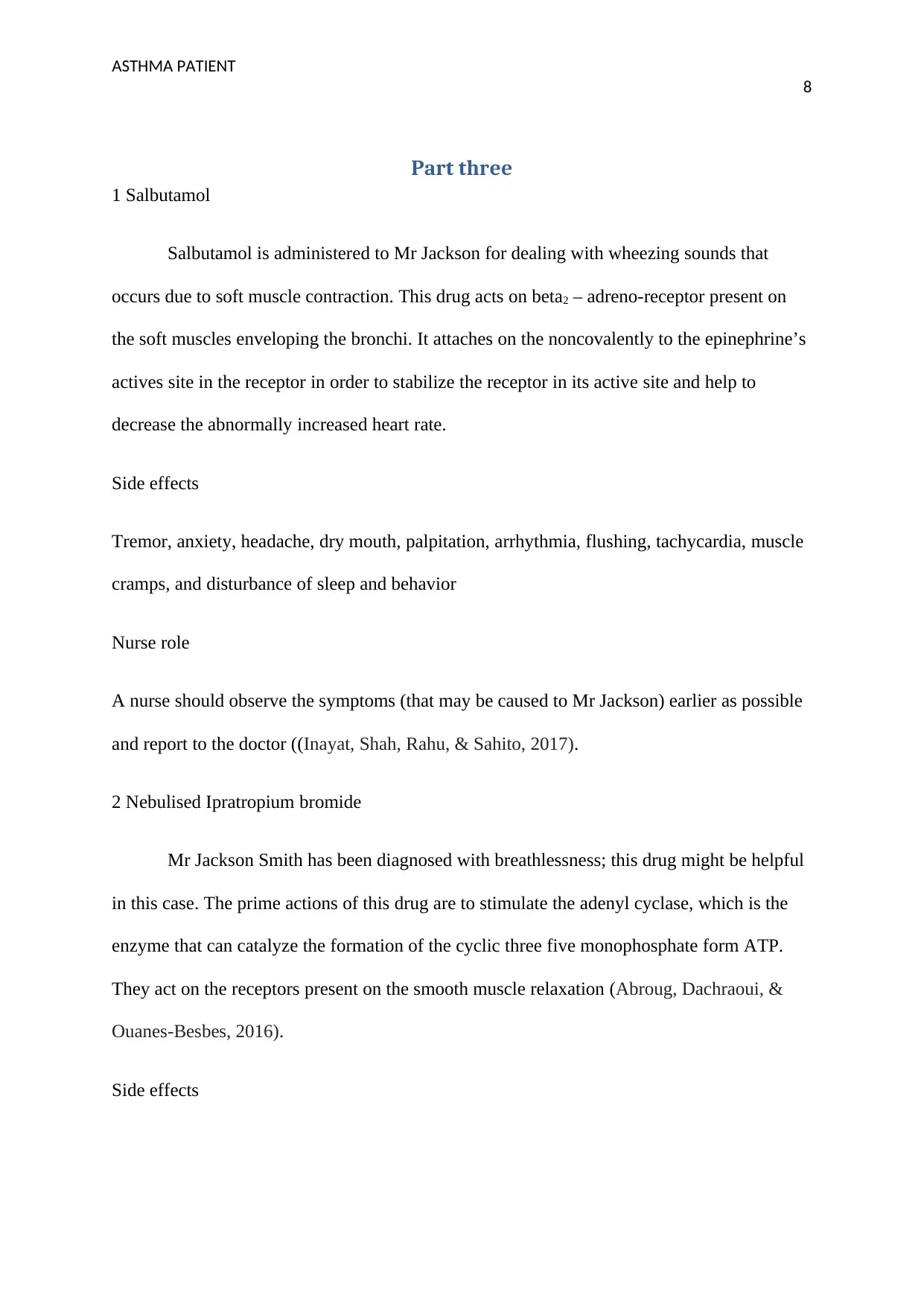
ASTHMA PATIENT
8
Part three
1 Salbutamol
Salbutamol is administered to Mr Jackson for dealing with wheezing sounds that
occurs due to soft muscle contraction. This drug acts on beta2 – adreno-receptor present on
the soft muscles enveloping the bronchi. It attaches on the noncovalently to the epinephrine’s
actives site in the receptor in order to stabilize the receptor in its active site and help to
decrease the abnormally increased heart rate.
Side effects
Tremor, anxiety, headache, dry mouth, palpitation, arrhythmia, flushing, tachycardia, muscle
cramps, and disturbance of sleep and behavior
Nurse role
A nurse should observe the symptoms (that may be caused to Mr Jackson) earlier as possible
and report to the doctor ((Inayat, Shah, Rahu, & Sahito, 2017).
2 Nebulised Ipratropium bromide
Mr Jackson Smith has been diagnosed with breathlessness; this drug might be helpful
in this case. The prime actions of this drug are to stimulate the adenyl cyclase, which is the
enzyme that can catalyze the formation of the cyclic three five monophosphate form ATP.
They act on the receptors present on the smooth muscle relaxation (Abroug, Dachraoui, &
Ouanes-Besbes, 2016).
Side effects
8
Part three
1 Salbutamol
Salbutamol is administered to Mr Jackson for dealing with wheezing sounds that
occurs due to soft muscle contraction. This drug acts on beta2 – adreno-receptor present on
the soft muscles enveloping the bronchi. It attaches on the noncovalently to the epinephrine’s
actives site in the receptor in order to stabilize the receptor in its active site and help to
decrease the abnormally increased heart rate.
Side effects
Tremor, anxiety, headache, dry mouth, palpitation, arrhythmia, flushing, tachycardia, muscle
cramps, and disturbance of sleep and behavior
Nurse role
A nurse should observe the symptoms (that may be caused to Mr Jackson) earlier as possible
and report to the doctor ((Inayat, Shah, Rahu, & Sahito, 2017).
2 Nebulised Ipratropium bromide
Mr Jackson Smith has been diagnosed with breathlessness; this drug might be helpful
in this case. The prime actions of this drug are to stimulate the adenyl cyclase, which is the
enzyme that can catalyze the formation of the cyclic three five monophosphate form ATP.
They act on the receptors present on the smooth muscle relaxation (Abroug, Dachraoui, &
Ouanes-Besbes, 2016).
Side effects
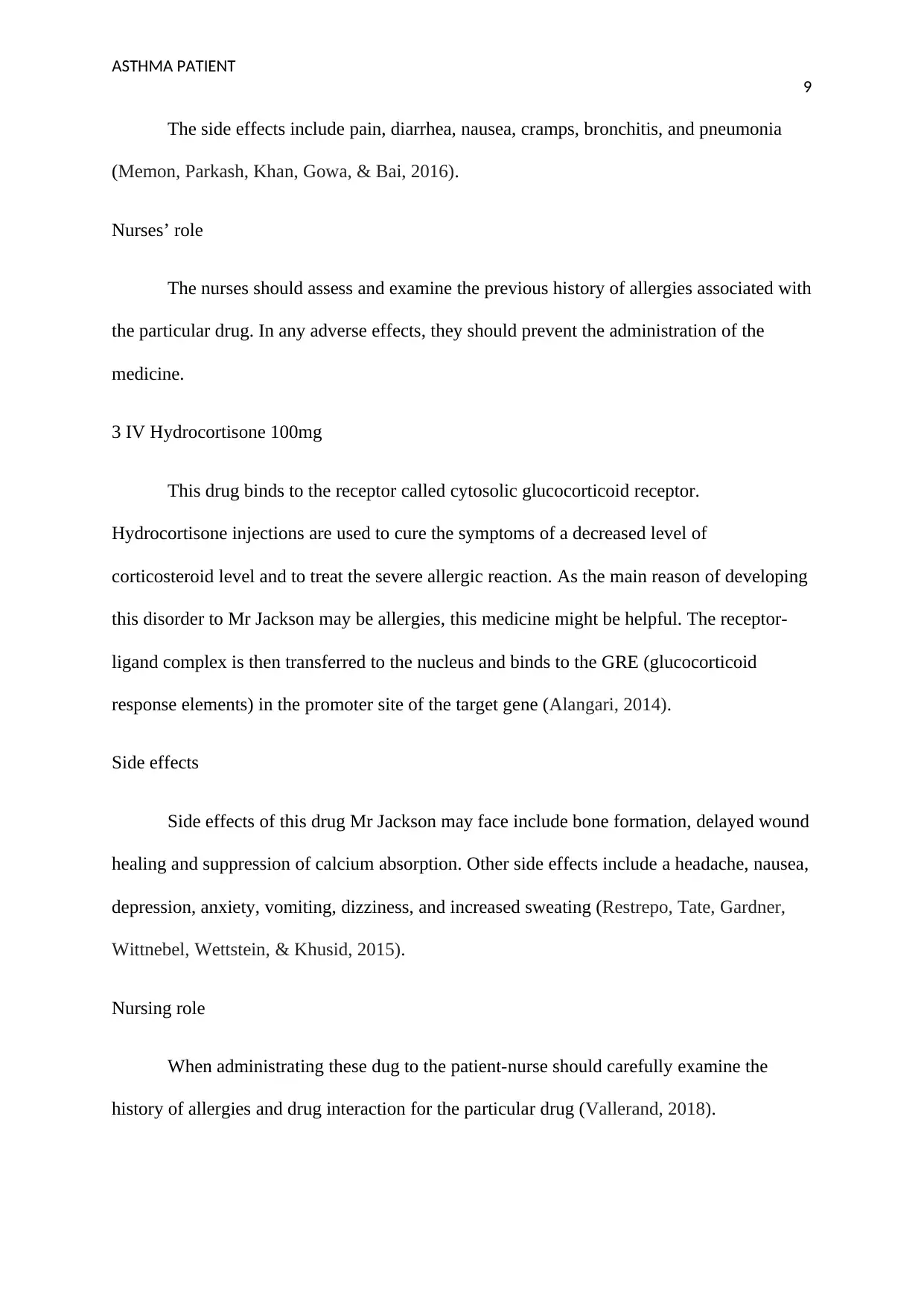
ASTHMA PATIENT
9
The side effects include pain, diarrhea, nausea, cramps, bronchitis, and pneumonia
(Memon, Parkash, Khan, Gowa, & Bai, 2016).
Nurses’ role
The nurses should assess and examine the previous history of allergies associated with
the particular drug. In any adverse effects, they should prevent the administration of the
medicine.
3 IV Hydrocortisone 100mg
This drug binds to the receptor called cytosolic glucocorticoid receptor.
Hydrocortisone injections are used to cure the symptoms of a decreased level of
corticosteroid level and to treat the severe allergic reaction. As the main reason of developing
this disorder to Mr Jackson may be allergies, this medicine might be helpful. The receptor-
ligand complex is then transferred to the nucleus and binds to the GRE (glucocorticoid
response elements) in the promoter site of the target gene (Alangari, 2014).
Side effects
Side effects of this drug Mr Jackson may face include bone formation, delayed wound
healing and suppression of calcium absorption. Other side effects include a headache, nausea,
depression, anxiety, vomiting, dizziness, and increased sweating (Restrepo, Tate, Gardner,
Wittnebel, Wettstein, & Khusid, 2015).
Nursing role
When administrating these dug to the patient-nurse should carefully examine the
history of allergies and drug interaction for the particular drug (Vallerand, 2018).
9
The side effects include pain, diarrhea, nausea, cramps, bronchitis, and pneumonia
(Memon, Parkash, Khan, Gowa, & Bai, 2016).
Nurses’ role
The nurses should assess and examine the previous history of allergies associated with
the particular drug. In any adverse effects, they should prevent the administration of the
medicine.
3 IV Hydrocortisone 100mg
This drug binds to the receptor called cytosolic glucocorticoid receptor.
Hydrocortisone injections are used to cure the symptoms of a decreased level of
corticosteroid level and to treat the severe allergic reaction. As the main reason of developing
this disorder to Mr Jackson may be allergies, this medicine might be helpful. The receptor-
ligand complex is then transferred to the nucleus and binds to the GRE (glucocorticoid
response elements) in the promoter site of the target gene (Alangari, 2014).
Side effects
Side effects of this drug Mr Jackson may face include bone formation, delayed wound
healing and suppression of calcium absorption. Other side effects include a headache, nausea,
depression, anxiety, vomiting, dizziness, and increased sweating (Restrepo, Tate, Gardner,
Wittnebel, Wettstein, & Khusid, 2015).
Nursing role
When administrating these dug to the patient-nurse should carefully examine the
history of allergies and drug interaction for the particular drug (Vallerand, 2018).
Secure Best Marks with AI Grader
Need help grading? Try our AI Grader for instant feedback on your assignments.

ASTHMA PATIENT
10
10
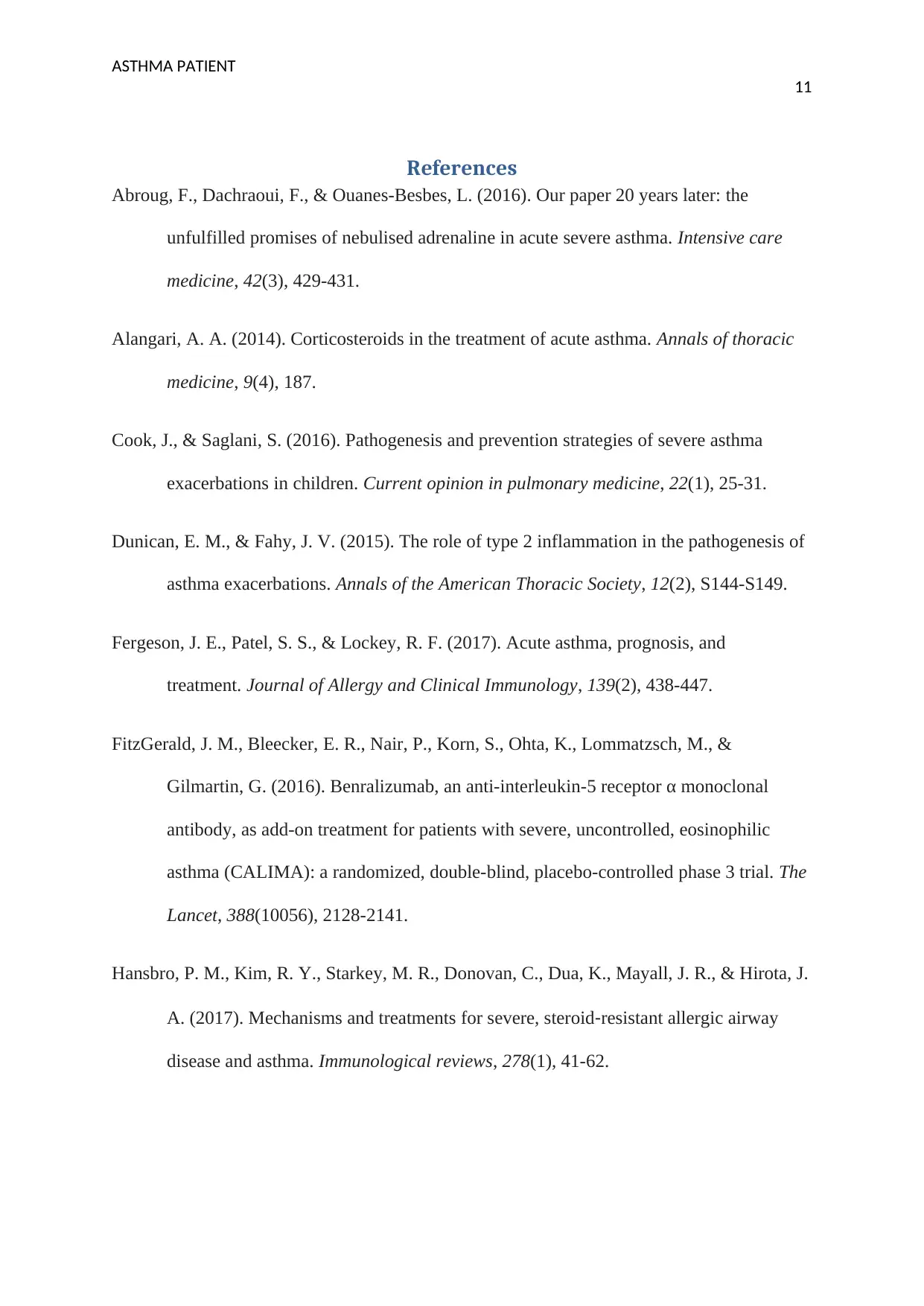
ASTHMA PATIENT
11
References
Abroug, F., Dachraoui, F., & Ouanes-Besbes, L. (2016). Our paper 20 years later: the
unfulfilled promises of nebulised adrenaline in acute severe asthma. Intensive care
medicine, 42(3), 429-431.
Alangari, A. A. (2014). Corticosteroids in the treatment of acute asthma. Annals of thoracic
medicine, 9(4), 187.
Cook, J., & Saglani, S. (2016). Pathogenesis and prevention strategies of severe asthma
exacerbations in children. Current opinion in pulmonary medicine, 22(1), 25-31.
Dunican, E. M., & Fahy, J. V. (2015). The role of type 2 inflammation in the pathogenesis of
asthma exacerbations. Annals of the American Thoracic Society, 12(2), S144-S149.
Fergeson, J. E., Patel, S. S., & Lockey, R. F. (2017). Acute asthma, prognosis, and
treatment. Journal of Allergy and Clinical Immunology, 139(2), 438-447.
FitzGerald, J. M., Bleecker, E. R., Nair, P., Korn, S., Ohta, K., Lommatzsch, M., &
Gilmartin, G. (2016). Benralizumab, an anti-interleukin-5 receptor α monoclonal
antibody, as add-on treatment for patients with severe, uncontrolled, eosinophilic
asthma (CALIMA): a randomized, double-blind, placebo-controlled phase 3 trial. The
Lancet, 388(10056), 2128-2141.
Hansbro, P. M., Kim, R. Y., Starkey, M. R., Donovan, C., Dua, K., Mayall, J. R., & Hirota, J.
A. (2017). Mechanisms and treatments for severe, steroid‐resistant allergic airway
disease and asthma. Immunological reviews, 278(1), 41-62.
11
References
Abroug, F., Dachraoui, F., & Ouanes-Besbes, L. (2016). Our paper 20 years later: the
unfulfilled promises of nebulised adrenaline in acute severe asthma. Intensive care
medicine, 42(3), 429-431.
Alangari, A. A. (2014). Corticosteroids in the treatment of acute asthma. Annals of thoracic
medicine, 9(4), 187.
Cook, J., & Saglani, S. (2016). Pathogenesis and prevention strategies of severe asthma
exacerbations in children. Current opinion in pulmonary medicine, 22(1), 25-31.
Dunican, E. M., & Fahy, J. V. (2015). The role of type 2 inflammation in the pathogenesis of
asthma exacerbations. Annals of the American Thoracic Society, 12(2), S144-S149.
Fergeson, J. E., Patel, S. S., & Lockey, R. F. (2017). Acute asthma, prognosis, and
treatment. Journal of Allergy and Clinical Immunology, 139(2), 438-447.
FitzGerald, J. M., Bleecker, E. R., Nair, P., Korn, S., Ohta, K., Lommatzsch, M., &
Gilmartin, G. (2016). Benralizumab, an anti-interleukin-5 receptor α monoclonal
antibody, as add-on treatment for patients with severe, uncontrolled, eosinophilic
asthma (CALIMA): a randomized, double-blind, placebo-controlled phase 3 trial. The
Lancet, 388(10056), 2128-2141.
Hansbro, P. M., Kim, R. Y., Starkey, M. R., Donovan, C., Dua, K., Mayall, J. R., & Hirota, J.
A. (2017). Mechanisms and treatments for severe, steroid‐resistant allergic airway
disease and asthma. Immunological reviews, 278(1), 41-62.
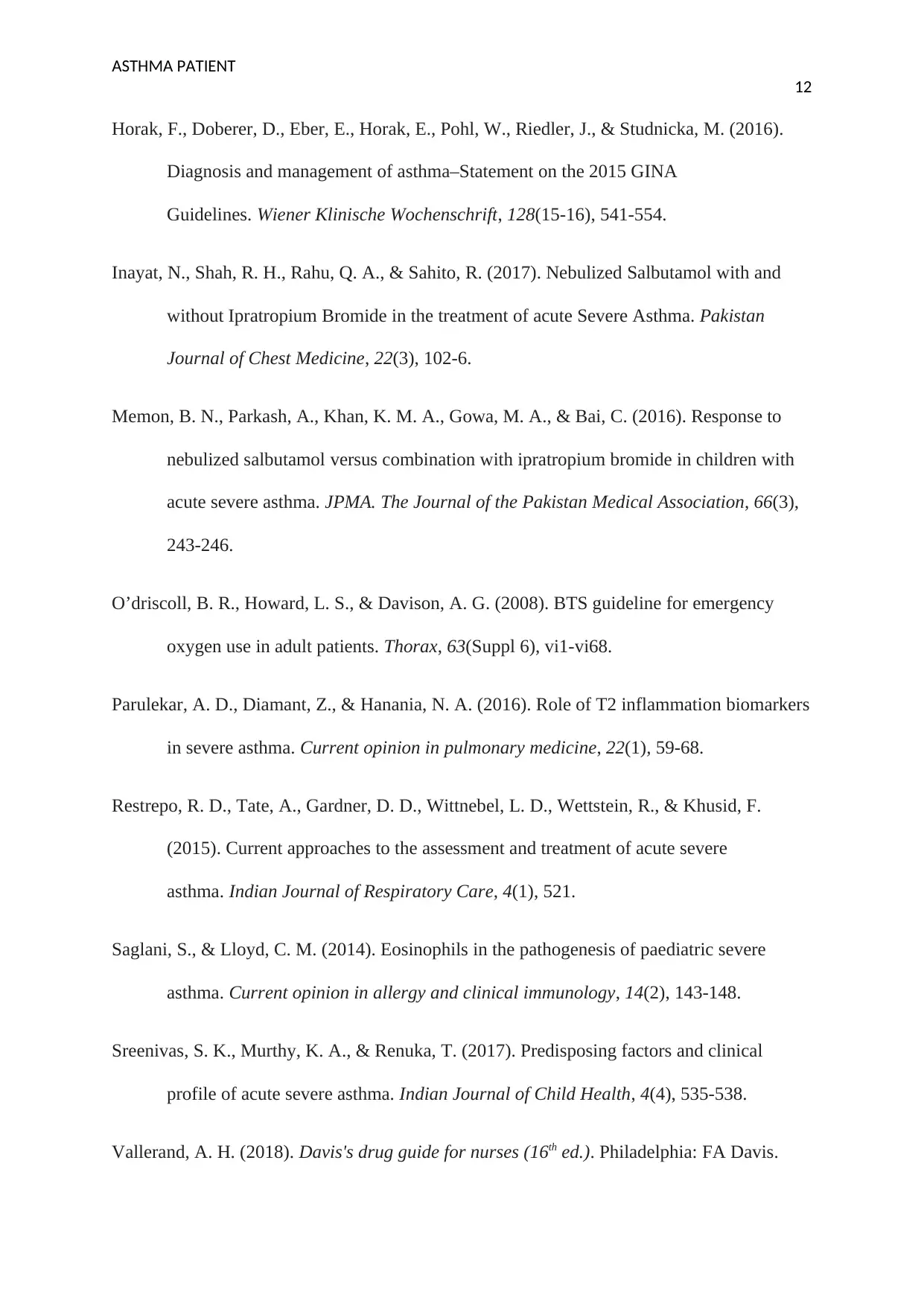
ASTHMA PATIENT
12
Horak, F., Doberer, D., Eber, E., Horak, E., Pohl, W., Riedler, J., & Studnicka, M. (2016).
Diagnosis and management of asthma–Statement on the 2015 GINA
Guidelines. Wiener Klinische Wochenschrift, 128(15-16), 541-554.
Inayat, N., Shah, R. H., Rahu, Q. A., & Sahito, R. (2017). Nebulized Salbutamol with and
without Ipratropium Bromide in the treatment of acute Severe Asthma. Pakistan
Journal of Chest Medicine, 22(3), 102-6.
Memon, B. N., Parkash, A., Khan, K. M. A., Gowa, M. A., & Bai, C. (2016). Response to
nebulized salbutamol versus combination with ipratropium bromide in children with
acute severe asthma. JPMA. The Journal of the Pakistan Medical Association, 66(3),
243-246.
O’driscoll, B. R., Howard, L. S., & Davison, A. G. (2008). BTS guideline for emergency
oxygen use in adult patients. Thorax, 63(Suppl 6), vi1-vi68.
Parulekar, A. D., Diamant, Z., & Hanania, N. A. (2016). Role of T2 inflammation biomarkers
in severe asthma. Current opinion in pulmonary medicine, 22(1), 59-68.
Restrepo, R. D., Tate, A., Gardner, D. D., Wittnebel, L. D., Wettstein, R., & Khusid, F.
(2015). Current approaches to the assessment and treatment of acute severe
asthma. Indian Journal of Respiratory Care, 4(1), 521.
Saglani, S., & Lloyd, C. M. (2014). Eosinophils in the pathogenesis of paediatric severe
asthma. Current opinion in allergy and clinical immunology, 14(2), 143-148.
Sreenivas, S. K., Murthy, K. A., & Renuka, T. (2017). Predisposing factors and clinical
profile of acute severe asthma. Indian Journal of Child Health, 4(4), 535-538.
Vallerand, A. H. (2018). Davis's drug guide for nurses (16th ed.). Philadelphia: FA Davis.
12
Horak, F., Doberer, D., Eber, E., Horak, E., Pohl, W., Riedler, J., & Studnicka, M. (2016).
Diagnosis and management of asthma–Statement on the 2015 GINA
Guidelines. Wiener Klinische Wochenschrift, 128(15-16), 541-554.
Inayat, N., Shah, R. H., Rahu, Q. A., & Sahito, R. (2017). Nebulized Salbutamol with and
without Ipratropium Bromide in the treatment of acute Severe Asthma. Pakistan
Journal of Chest Medicine, 22(3), 102-6.
Memon, B. N., Parkash, A., Khan, K. M. A., Gowa, M. A., & Bai, C. (2016). Response to
nebulized salbutamol versus combination with ipratropium bromide in children with
acute severe asthma. JPMA. The Journal of the Pakistan Medical Association, 66(3),
243-246.
O’driscoll, B. R., Howard, L. S., & Davison, A. G. (2008). BTS guideline for emergency
oxygen use in adult patients. Thorax, 63(Suppl 6), vi1-vi68.
Parulekar, A. D., Diamant, Z., & Hanania, N. A. (2016). Role of T2 inflammation biomarkers
in severe asthma. Current opinion in pulmonary medicine, 22(1), 59-68.
Restrepo, R. D., Tate, A., Gardner, D. D., Wittnebel, L. D., Wettstein, R., & Khusid, F.
(2015). Current approaches to the assessment and treatment of acute severe
asthma. Indian Journal of Respiratory Care, 4(1), 521.
Saglani, S., & Lloyd, C. M. (2014). Eosinophils in the pathogenesis of paediatric severe
asthma. Current opinion in allergy and clinical immunology, 14(2), 143-148.
Sreenivas, S. K., Murthy, K. A., & Renuka, T. (2017). Predisposing factors and clinical
profile of acute severe asthma. Indian Journal of Child Health, 4(4), 535-538.
Vallerand, A. H. (2018). Davis's drug guide for nurses (16th ed.). Philadelphia: FA Davis.
Paraphrase This Document
Need a fresh take? Get an instant paraphrase of this document with our AI Paraphraser

ASTHMA PATIENT
13
13
1 out of 14
Related Documents
Your All-in-One AI-Powered Toolkit for Academic Success.
+13062052269
info@desklib.com
Available 24*7 on WhatsApp / Email
![[object Object]](/_next/static/media/star-bottom.7253800d.svg)
Unlock your academic potential
© 2024 | Zucol Services PVT LTD | All rights reserved.




